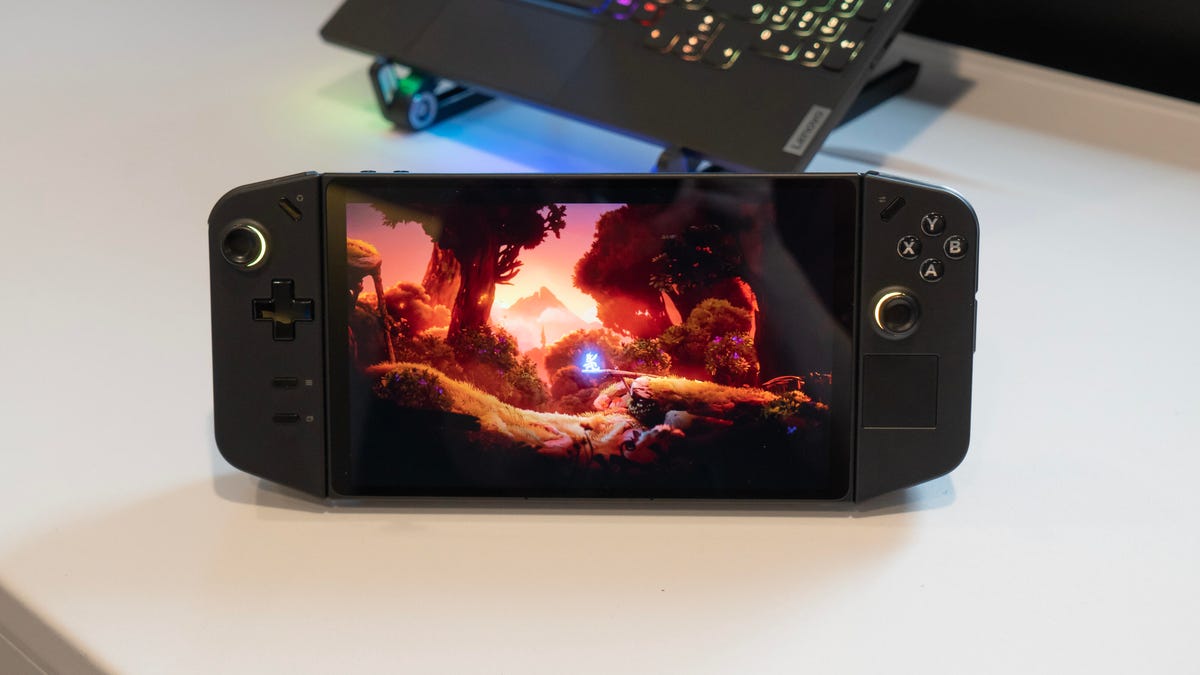Lenovo Legion Go: Nintendo Switch Meets Steam Deck With Windows
We played with Lenovo's latest entry to the fast-changing PC gaming handheld space. It's a bold yet familiar idea.

The Lenovo Legion Go: a whole new entry to the PC gaming handheld space.
Ever since Valve introduced the Steam Deck, taking PC games on the go via a handheld gaming device was no longer an impossible dream. The Steam Deck skips using Windows entirely, however, while other manufacturers like Asus with its ROG Ally, and now Lenovo's Legion Go are essentially handheld Windows gaming PCs. Lenovo adds something the Ally doesn't, though: Nintendo Switch-like detachable controllers.
The Go's release timing and price -- Oct. 23, starting at $699 -- puts it into the mix for holiday shopping, although depending on how you spec it out, you may be shooting up closer to $1,000.
The Legion Go, which we got a chance to play with during an early demo session in New York, is built around a big 8.8-inch display with a useful kickstand on its back and, most importantly, those controllers that detach from its sides. That not only allows for multiplayer gaming, but it means you can play games more easily when the Legion Go is docked or resting on its kickstand. It gives the Legion Go all the flexibility of the Nintendo Switch, not just some of it like the Steam Deck, which has dock options but no detachable controllers.
The Lenovo Legion Go's controllers detach like Switch Joy-Cons. Steam Deck, we're looking at you.
The Legion Go's specs on paper give it a clear edge over Steam Deck, too: the processor's an AMD Ryzen Z1, and the 8.8-inch display has a 2,560x1,600-pixel resolution and up to a 144Hz refresh rate, which crushes the Steam Deck's 720p screen. The Legion Go's internal storage options max at 1TB (twice that of the top Steam Deck configuration) with microSD card support up to 2TB, and up to 16GB of RAM.
Each controller works wirelessly when detached, similar to the Switch's Joy-Cons, and Lenovo also adds a clever touch by having the controller dock to a base to turn it into a throttle-like joystick. Lenovo also has another way to remotely play with the Legion Go beyond using the kickstand and dock: A new pair of display-enabled glasses, sold as a Legion Go accessory, can float a virtual display in the air similar to how the Steam Deck already supports plugged-in smart glasses.
However, the Legion Go is heavy -- 1.9 pounds with the controllers -- big and potentially more expensive based on how you add on extras (more storage, those glasses or separately sold headphones).
The Legion Go is big, but it feels comfortable enough to hold.
Hands-on thoughts
CNET's Lori Grunin got to play with it for a little while, and came away with some initial thoughts about it compared to Steam Deck and the Asus ROG Ally:
Features: Lenovo looks to be tossing in all the features, a kitchen-sink-type approach. It seems well done, but also possibly overdone for what it needs in some instances.
Weight: Although it weighs almost 2 pounds, in practice it doesn't feel that heavy. Then again, after a few hours of play it might be.
The Legion Go has plenty of controls on the back as well as the front. And the kickstand is a big plus.
Windows: It's helpful to run Windows, but the OS isn't optimized for a small screen. Also, manipulating the touchscreen can get awkward, and the touchpad on the right controller seemed a bit uncomfortable. Then again, this was a preproduction demo.
Display: The screen is very nice for IPS LCD vs. OLED, bright with reasonably high contrast. It's larger than most and feels notably more game-friendly than a phone-plus-controller combo.
The Legion Go's clever table-stick base makes for throttle-like controller options.
Controls: They're fine, and work well. But are there too many? Sometimes a few of the big buttons on the grips were easy to accidentally trigger while playing.
Removable controllers: They're easy to detach and reattach, but there's no way to join them into a single wireless controller like the Switch can do. Being able to use the right controller as a table stick is clever, but it may not be practical.
Kickstand: It's solid and allows lots of angle adjustments.
The Legion Go's controls feel familiar, although the trackpad is only on one side.
An encouraging sign for handheld gaming?
Lenovo's handheld is one of a whole bunch of recent handheld gaming developments: Sony's PS5-required PlayStation Portal, Qualcomm's next-gen mobile gaming chips and concept hardware and ongoing rumors of a new Nintendo Switch next year.
Handheld gaming has been splitting into several categories lately: streaming-focused devices, mobile-based handhelds or accessories for phones, retro-focused handhelds and portable gaming PCs. The handheld PC space is the one poised for the most change, especially if Microsoft ever formally decides to support handhelds via Windows or Xbox (or both) with OS features that optimize for these formats.
It's clear that hardware manufacturers are ready, though. From both a chipset and physical design standpoint, companies like Lenovo appear set to dive in. It looks like the handheld gaming space is getting much more interesting than it's been in years.



